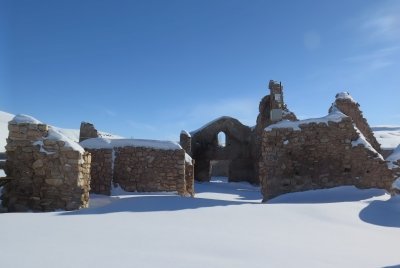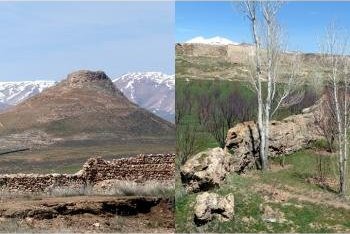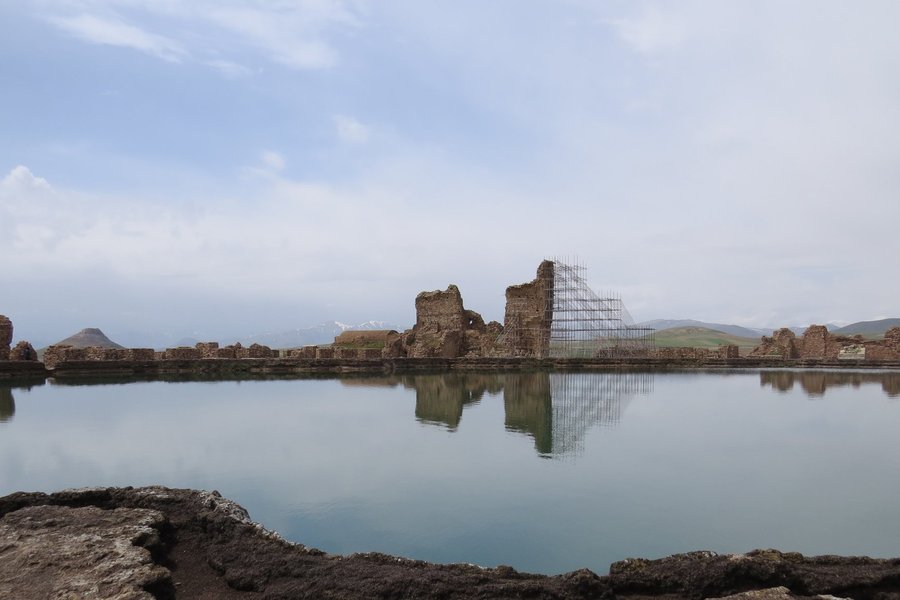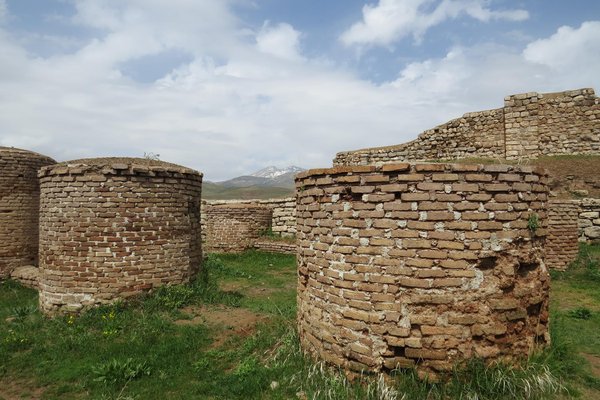Iran
Takht-e Soleyman
Takht-e Soleyman is the holiest shrine of Zoroastrianism and the most important relic of the former Sassanid Empire.
It dates from the 6th century but was partially rebuilt during the Ilkhanid period (13th-14th century): they added new constructions and reused the site as a palace. The area includes Takht-e Soleyman with its fire temple and Anahita temple, the small hill Zendan-e Suleiman (‘Solomon’s prison’), a mountain to the east that served as a quarry for the construction of the site, the archaeological mound Tepe Majid and Belqeis Mountain with a citadel.
Community Perspective: Go there for its mountain scenery and an introduction to Zoroastrianism, says Els. You can even visit in winter, as Zoë did. And oh, it isn’t a volcano (as Solivagant explains)!
Site Info
Official Information
- Full Name
- Takht-e Soleyman (ID: 1077)
- Country
- Iran
- Status
-
Inscribed 2003
Site history
History of Takht-e Soleyman
- 2003: Inscribed
- Inscribed
- Type
- Cultural
- Criteria
- i
- ii
- iii
- iv
- vi
Links
- UNESCO
- whc.unesco.org
- Official
-
- visitiran.ir — Visit Iran
- Related
-
- noviceview.wordpress.com — Extensive Trip Report: On the way to Takht-e Soleyman
- teheran.ir — Takht-e Soleyman in La Revue de Teheran (in French)
- iranicaonline.org — Encyclopaedia Iranica
All Links
UNESCO.org
- whc.unesco.org — whc.unesco.org/
Official Website
- visitiran.ir — Visit Iran
Related Resources
- noviceview.wordpress.com — Extensive Trip Report: On the way to Takht-e Soleyman
- teheran.ir — Takht-e Soleyman in La Revue de Teheran (in French)
- iranicaonline.org — Encyclopaedia Iranica
- sacredsites.com — Link
Community Information
- Community Category
- Archaeological site: Near Eastern
Travel Information
Red Zone Travel Advisory
Recent Connections
-
Perfect Inscriptions
2003 -
Red Zone Travel Advisory
Iran fully off-limits -
Untranslated Toponyms
"Takht" in Farsi originally meant "Bed"…
Connections of Takht-e Soleyman
- Individual People
-
-
King Solomon
The "Throne of Solomon" (the site also contains the Zendan or "Prison of Solomon"). The connection (and hence the name) is entirely legendary though the site is considerably older than the c 6th Century CE Sassanian period which is mainly represented in the remains and goes back to the first millenium BCE (which is contemporaneous with Solomon)
-
- Geography
-
-
Kurdistan
Seen as part of 'Greater Kurdistan'
-
- Trivia
-
-
Cultural sites closely connected to volcanoes
it contains a volcano and an artesian lake as essential elements of the site (Unesco website)
-
- History
-
-
Parthian Empire
Archaeological excavations have revealed traces of a 5th century BC occupation during the Achaemenid period, as well as later Parthian settlements in the citadel. (Wiki) -
Sassanid Empire
-
Silk Roads
(Near) Classic Land Route; in ICOMOS thematic study but no details on role or function -
Byzantine Empire and Civilization
"was destroyed in AD627 by the Byzantine army of Heraclius I in a counter attack for the Sassanian invasion of the Roman armies. The Byzantines destroyed the fire temple and took away its treasures which were offereings by Sassanian kings. The site fell into disuse and was subsequently abandoned". See Byzantine-Sassanian War 602-628See en.wikipedia.org
-
- World Heritage Process
-
-
Perfect Inscriptions
2003 -
WHS with enclave
Nosratabad village -
Incorrect UNESCO 'Number of locations'
UNESCO has 1, but there are 7 separate areas shown on the map (1 main location and 6 numbered units in the buffer zone)
-
- Religion and Belief
-
-
Legends and Folk Myths
Folk legend relates that King Solomon used to imprison monsters inside the 100 m deep crater of the nearby Zendan-e Soleyman "Prison of Solomon" -
Holiest place
Zoroastrianism -
Zoroastrianism
citadel includes the remains of a Zoroastrian fire temple
-
- Human Activity
-
-
Stone Quarries
"The mountain to the east was used by the Sasanians as a quarry for building stone." (AB eval) -
Irrigation and drainage
residents of the area have created canals to channel the overflow as well as provide irrigation for surrounding fields, which, as a result, are specially fertile
-
- Timeline
-
-
Built in the 6th century
The site became a royal Zoroastrian sanctuary under Khosrow I (531-579) and Khosrow II (591-628), and it was the most important of the three main Zoroastrians sanctuaries. (AB ev)
-
- Visiting conditions
-
-
Red Zone Travel Advisory
Iran fully off-limits
-
- WHS Names
-
-
Untranslated Toponyms
"Takht" in Farsi originally meant "Bed", then "top" or "throne". It is often used in Iran, Pakistan and India across different religions (including e.g Sikhism) as a prefix or suffix for names of places or institutions that have historical or religious significance
-
News
No news.
Recent Visitors
Visitors of Takht-e Soleyman
- AC
- Afshin Iranpour
- Alexander Barabanov
- Alexander Parsons
- Atila Ege
- AYB
- BaziFettehenne
- Els Slots
- Erik Jelinek
- Harry Mitsidis
- henryjiao18
- Ivan Rucek
- Jacob Otten
- Jean Lecaillon
- Jonas Kremer
- Joyce van Soest
- Ken DJ
- Knut
- Martina Rúčková
- Nihal Ege
- Roman Bruehwiler
- Solivagant
- Szucs Tamas
- Thomas Buechler
- Timothy C Easton
- Wojciech Fedoruk
- Zoë Sheng
Community Reviews
Show full reviews
Going to Iran in winter has obvious risks of snow ruining your plans. Taking the smaller eastern road into Soleyman, it was cleared but still a few ice patches, the road leading out West was much better. However, the actual site was covered by half a meter of beautiful white snow. Missing the plowed parking spaces at the bottom I drove right up through the gate and parked next to the staff. When they pointed it out I apologized but pointed at my watch for it was getting late and they let me stay there. I will thus start a new connection of “Zoë parked here illegally” (kidding but I also have Sharjah Airport Museum, Alisadr Cave and errr Rome [/w Parking Ticket I never got to pay, long story]). The staff mainly wanted to ensure I bought a ticket so I waded over to the booth yet he didn't have change for a 500k note. In typical fashion I got waved through (I later returned to see if he has change but he waved me away again so this now on my “Zoë has free entry” connection).
As for the site itself it was unfortunately hard to even read the snowed in panels and make out what some of the buildings were supposed to be, but I reckon it is just my misfortune with the weather. The lake was still beautiful and the surrounding scenery made it clear why the fortification was up here. Some of the men …
Keep reading 0 comments
Wiki describes Takht-e Soleyman as being “located on a volcano crater rim” whilst the UNESCO Web site states “About 3 kms west is an ancient volcano, Zendan-e Soleyman which rises about 100m above its surroundings”. In fact the former is not on a “volcano crater rim” and the latter is not a 100m high “ancient volcano”!
Both sites have been formed by the same, rather different, geological process. Britannica says (correctly) of the main site “The base of the temple complex sits on an oval mound roughly 1,150 by 1,800 feet (350 by 550 meters) that was formed by the outflow of a deep artesian spring, the waters of which collect in a large lake at the southern half of the hill and have heavy concentrations of dissolved calcium. The resultant limestone formation, created by the residue of the periodic inundation of the spring, rises to about 200 feet (60 meters) above the surrounding countryside”
But Britannica isn’t so accurate with Zendan-e Soleyman which it describes as “a modest-sized extinct volcano”! Why it couldn’t have carried forward the same geological process it has correctly identified as having created Tahkt-e Soleyman isn’t clear. It isn’t alone however! The AB evaluation describes it as “This hollow, conical mountain, an ancient volcano”. On the other hand the Nomination file is very careful to describe the Zendan as simply being “volcano-shaped”. Whilst the notice board at the foot of …
Keep reading 0 comments
Takht-e Soleyman is one of these names on the WH List that mean nothing unless you’ve been there. It ranked among the very lowest in our recent Community and Popular Votes for the WHS Top 200, probably because almost nobody had visited it (13 were there before Solivagant and I visited in April/May 2016). It ended up being my favourite WHS of Northern Iran, both for its colourful mountain scenery and introduction to Zoroastrianism. We spent 3 hours there, but I could easily have stayed an hour more.
Takht-e-Soleyman (meaning: “the throne of Solomon”, an apocryphal name given during the Arab conquest) was the spiritual center of Zoroastrianism. It was created in the 6th century by the Persian Empire of the Sassanids, who were in fierce competition with the Byzantine Empire and Christianity and wanted to build a showcase for their own citizens.
Despite reading various sources beforehand and listening to the explanations of our tour guides, I find summarizing the faith of the Zoroastrians difficult. They worshipped one god, but in their temples, the focus is on the four elements of water, earth, air and fire. The combined presence of a volcano (fire) and a natural spring (water) made Takht-e Soleyman an especially auspicious location for Zoroastrians.
After a nutritious lunch in the canteen of a nearby mine, where we met two bewildered French tourists travelling with their own campervan, we started our visit to the volcano. This is nicknamed ‘Solomon’s Prison’ (Zendan-e Soleyman): folk tales suggest that King …
Keep reading 0 comments
Hi and thank you so much for giving us a chance for writing about Takht-suleyman. I am orignally from Takab Afshar, located 40 kilometers Northwest of the site. i grew up in Takab and i live there for 19 years. on fridays, the first thing we thought of with freinds was to go there and enjoy the beautiful scenery and weather. you know you have a kind of strength there,whenever i was there, i could breathe my predecessors. the air the took in their lungs. i feel free there. it's been 5 years i have left my home town and i was living Tabriz and now in Tehran. when i just think of this place and how much i miss it. my heart fills with the nostalgia to go there again to be and forget whatever the modern civilization have given us along with sadnesses. i miss there so much that my heart is bursting and my eyes are full of tears for i have lived this place of my ancestors. Again I thank you to give me some space to share what I feel being not there. I strongle recommend anyone who would read this material to get a chance and visit this historical fire temple of the most lovely religion of Zolostrians. You would feel what meant good speech, good deeds and good thoughts. and back to civilization you would miss it so much.
Keep reading 0 comments


